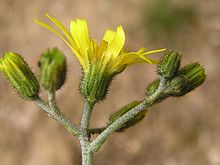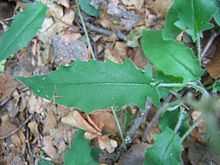Forest hawkweed
| Forest hawkweed | ||||||||||||
|---|---|---|---|---|---|---|---|---|---|---|---|---|

Forest hawkweed ( Hieracium murorum ) |
||||||||||||
| Systematics | ||||||||||||
|
||||||||||||
| Scientific name | ||||||||||||
| Hieracium murorum | ||||||||||||
| L. |
The forest-hawkweed ( Hieracium murorum , Syn. : Hieracium sylvaticum ), also wall-hawkweed called, is a plant type from the family of the daisy family (Asteraceae).
Plant description
The forest hawkweed is a perennial , herbaceous plant that reaches heights of between 20 and 60 centimeters.
Except for one or two smaller stem leaves, all leaves are basal. The lanceolate , broadly lanceolate to elongated egg-shaped leaves are truncated at the base or are heart-shaped with two rearwardly directed teeth. The leaf margin is coarse in the lower part, often only slightly serrated in the upper part. The pure green or reddish dotted leaves are sparse, but long hairy. The leaf stalks, like the stem, are covered with long hair and denser short hair. Glandular hairs are absent on leaves and stems.
Two to eight cup-shaped partial inflorescences are in a panicle inflorescence . The bracts of the flower heads, like the inflorescence stalks, are richly hairy, but other hairs are almost completely absent from the bracts. Many yellow flowers stand together in each flower head . All flowers are five-lobed ray florets .
They bloom from May to August.
The number of chromosomes is 2n = 18, 27 or 36.
Systematics
It is a relatively diverse species that also easily forms hybrids with other hawkweed species. More than 100 subspecies have been described in Germany alone . The Euro + Med Plantbase lists 191 subspecies.
ecology
The forest hawkweed is a hemicryptophyte and a half-rosette plant.
The flowers are cup-shaped flowers. Pollinators are bees . Flowering time is from May to August.
The fruits are unbeaked achenes with rough, brittle pappus . The spread occurs as an umbrella flyer and water-like. Fruit ripening is from June to August.
The vegetative reproduction takes place through the rhizome , there are no runners .
Distribution and location
The forest hawkweed occurs in the moderate , northern latitudes of Eurasia , especially in the mountainous regions. In Alaska , the western part of Canada and in the eastern parts of North America it was introduced ( neophyte ). It is widespread in Central Europe . In the Allgäu Alps it rises on the ridge north of the Derrenjoch west of the Obere Spital-Alpe near Baad in Vorarlberg up to 2000 m above sea level.
It grows in forests or on the edges of forests, mostly, but not necessarily, in drier places, as well as on mountain meadows, on gravel fields or on the bottom of walls. The forest hawkweed occurs mainly in societies of the Fagion association.
swell
- Werner Rothmaler : Excursion flora for the areas of the GDR and the FRG . Volume 2: Vascular Plants, 14th Edition. People and knowledge, Berlin 1988, ISBN 3-06-012539-2 .
- Otto Schmeil , Jost Fitschen, Werner Rauh: Flora of Germany and its adjacent areas . 84th edition. Quelle & Meyer, Heidelberg 1968.
- Ruprecht Düll , Herfried Kutzelnigg : Pocket dictionary of plants in Germany and neighboring countries. The most common Central European species in portrait. 7th, corrected and enlarged edition. Quelle & Meyer, Wiebelsheim 2011, ISBN 978-3-494-01424-1 .
Individual evidence
- ↑ a b Erich Oberdorfer : Plant-sociological excursion flora for Germany and neighboring areas . With the collaboration of Angelika Schwabe and Theo Müller. 8th, heavily revised and expanded edition. Eugen Ulmer, Stuttgart (Hohenheim) 2001, ISBN 3-8001-3131-5 , pp. 1009 .
- ↑ Werner Greuter (2006+): Compositae (pro parte majore). - In: W. Greuter & E. von Raab-Straube (eds.): Compositae. Euro + Med Plantbase - the information resource for Euro-Mediterranean plant diversity. Datasheet Hieracium murorum In: Euro + Med Plantbase - the information resource for Euro-Mediterranean plant diversity.
- ↑ Erhard Dörr, Wolfgang Lippert : Flora of the Allgäu and its surroundings. Volume 2, IHW, Eching 2004, ISBN 3-930167-61-1 , p. 715.
Web links
- Forest hawkweed. In: FloraWeb.de.
- Forest hawkweed . In: BiolFlor, the database of biological-ecological characteristics of the flora of Germany.
- Profile and distribution map for Bavaria . In: Botanical Information Hub of Bavaria .
- Hieracium murorum L. In: Info Flora , the national data and information center for Swiss flora . Retrieved July 11, 2016.
- Thomas Meyer: Hawkweed data sheet with identification key and photos at Flora-de: Flora von Deutschland (old name of the website: Flowers in Swabia )


